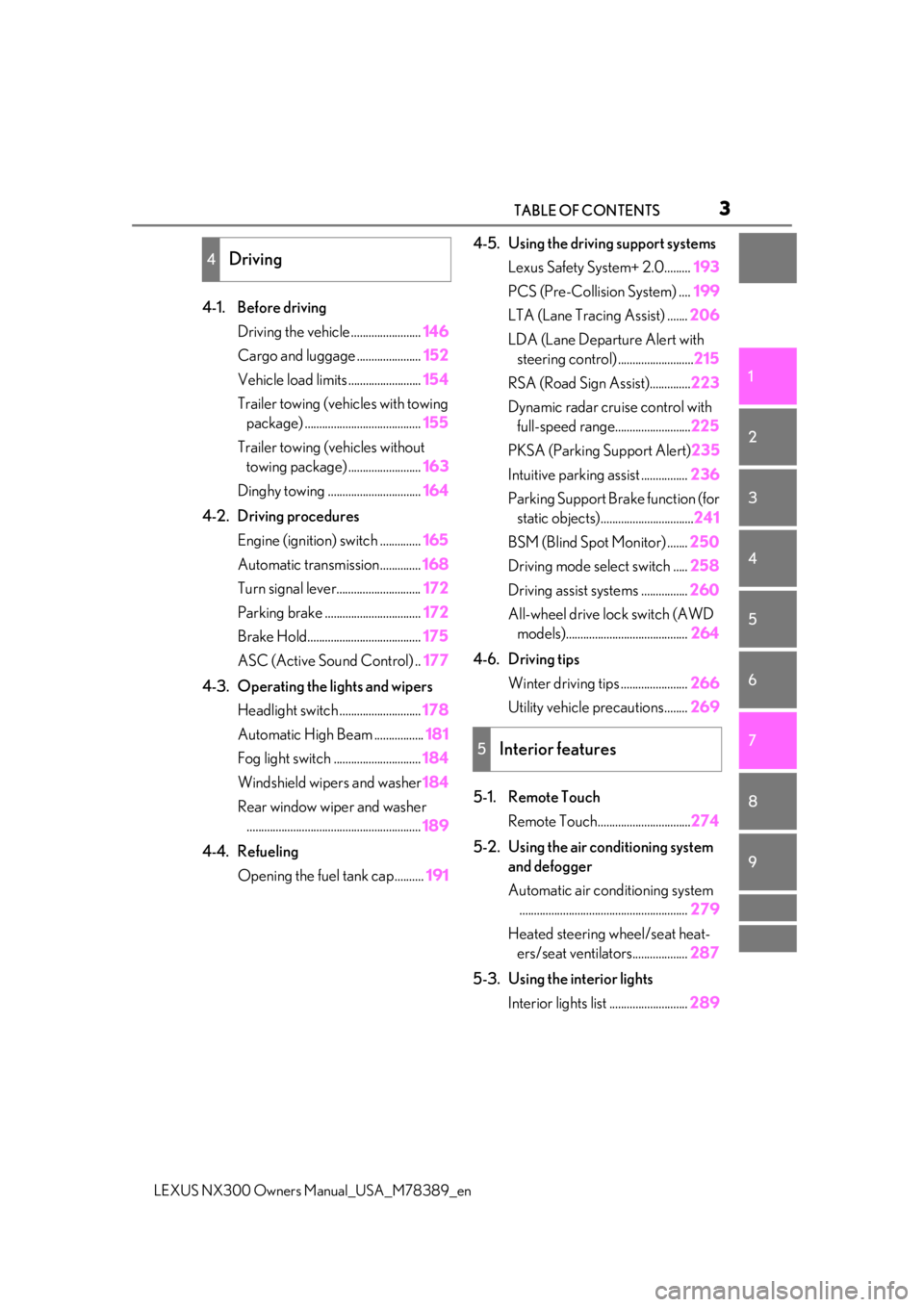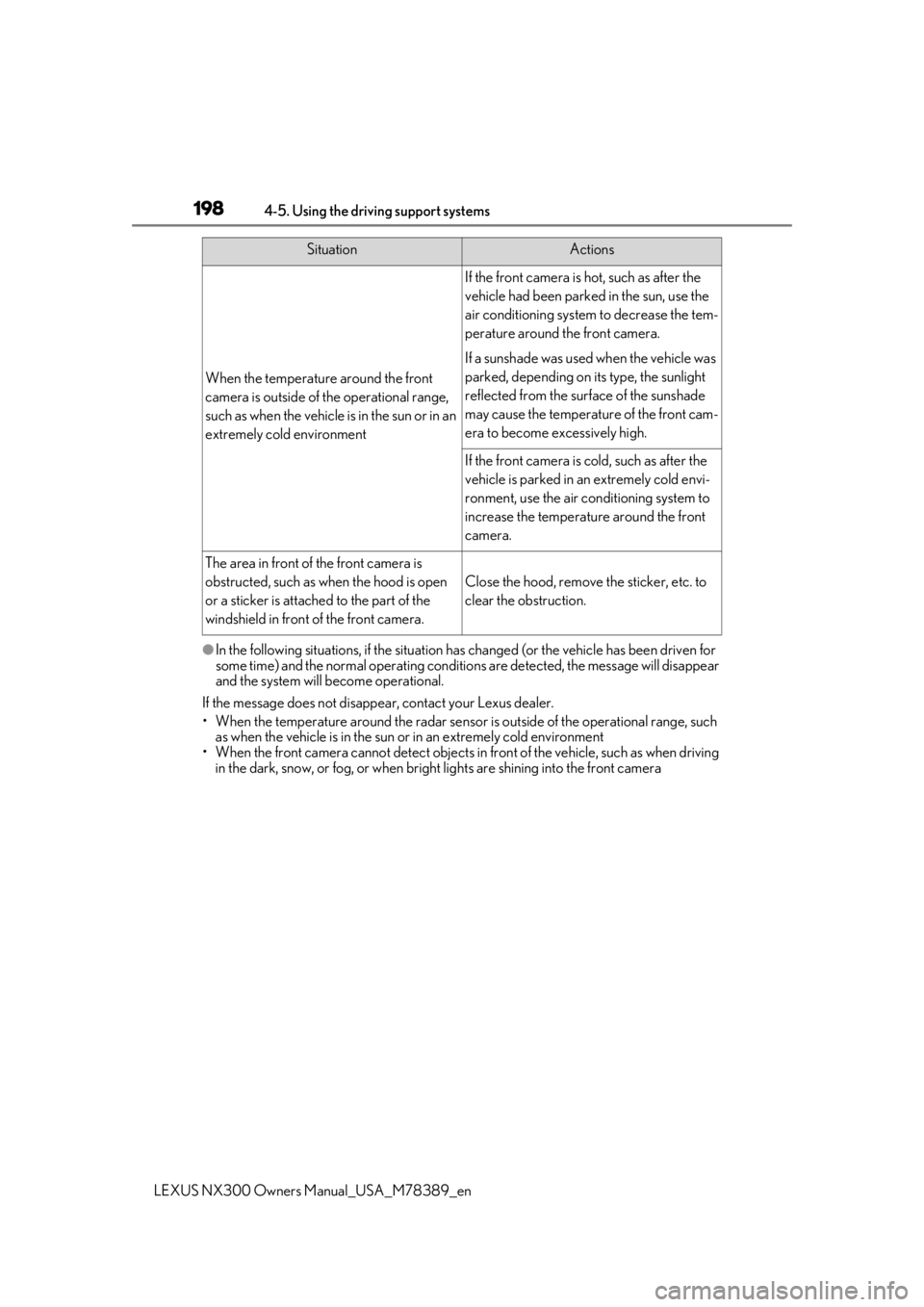air conditioning LEXUS NX300 2020 Owners Manual
[x] Cancel search | Manufacturer: LEXUS, Model Year: 2020, Model line: NX300, Model: LEXUS NX300 2020Pages: 468, PDF Size: 10.24 MB
Page 3 of 468

3TABLE OF CONTENTS
LEXUS NX300 Owners Manual_USA_M78389_en
1
2
3
4
5
6
7
8
9
4-1. Before driving
Driving the vehicle ........................ 146
Cargo and luggage ...................... 152
Vehicle load limits ......................... 154
Trailer towing (vehicles with towing package) ........................................ 155
Trailer towing (vehicles without towing package) ......................... 163
Dinghy towing ................................ 164
4-2. Driving procedures Engine (ignition) switch .............. 165
Automatic transmission.............. 168
Turn signal lever............................. 172
Parking brake ................................. 172
Brake Hold....................................... 175
ASC (Active Sound Control) .. 177
4-3. Operating the lights and wipers Headlight switch ............................ 178
Automatic High Beam ................. 181
Fog light switch .............................. 184
Windshield wipers and washer 184
Rear window wiper and washer ............................................................ 189
4-4. Refueling Opening the fuel tank cap.......... 1914-5. Using the driving support systems
Lexus Safety System+ 2.0......... 193
PCS (Pre-Collision System) .... 199
LTA (Lane Tracing Assist) ....... 206
LDA (Lane Departure Alert with steering control) .......................... 215
RSA (Road Sign Assist).............. 223
Dynamic radar cruise control with full-speed range.......................... 225
PKSA (Parking Support Alert) 235
Intuitive parking assist ................ 236
Parking Support Brake function (for static objects)................................ 241
BSM (Blind Spot Monitor) ....... 250
Driving mode select switch ..... 258
Driving assist systems ................ 260
All-wheel drive lock switch (AWD models).......................................... 264
4-6. Driving tips Winter driving tips ....................... 266
Utility vehicle precautions........ 269
5-1. Remote Touch Remote Touch................................ 274
5-2. Using the air conditioning system and defogger
Automatic air conditioning system.......................................................... 279
Heated steering wheel/seat heat- ers/seat ventilators................... 287
5-3. Using the interior lights Interior lights list ........................... 289
4Driving
5Interior features
Page 4 of 468

4TABLE OF CONTENTS
LEXUS NX300 Owners Manual_USA_M78389_en
5-4. Using the storage features
List of storage features............... 292
Luggage compartment features ........................................................... 295
5-5. Using the other interior features Other interior features .............. 299
Garage door opener.................. 309
Compass........................................... 315
6-1. Maintenance and care Cleaning and protecting the vehi-cle exterior ................................... 320
Cleaning and protecting the vehi- cle interior .................................... 323
6-2. Maintenance Maintenance requirements ..... 326
General maintenance ................ 327
Emission inspection and mainte- nance (I/M) programs ............ 330
6-3. Do-it-yourself maintenance Do-it-yourself service precautions............................................................ 331
Hood.................................................. 333
Positioning a floor jack............... 333
Engine compartment.................. 335
Tires ................................................... 343
Tire inflation pressure .................. 351
Wheels.............................................. 353
Air conditioning filter..................355
Electronic key battery ................ 356
Checking and replacing fuses 358
Headlight aim................................. 360
Light bulbs ........................................ 3617-1. Essential information
Emergency flashers .................... 366
If your vehicle has to be stopped in an emergency ............................ 366
If the vehicle is trapped in rising water .............................................. 367
7-2. Steps to take in an emergency If your vehicle needs to be towed.......................................................... 369
If you think something is wrong 373
Fuel pump shut off system ........ 374
If a warning light turns on or a warn- ing buzzer sounds..................... 375
If a warning messa ge is displayed
.......................................................... 384
If you have a flat tire .................... 387
If the engine will not start .......... 395
If you lose your keys.................... 396
If the fuel filler door cannot be opened .......................................... 397
If the electronic key does not oper- ate properly ................................. 397
If the vehicle battery is discharged .......................................................... 400
If your vehicle overheats ........... 403
If the vehicle becomes stuck ... 406
8-1. Specifications Maintenance data (fuel, oil level, etc.) ................................................. 408
Fuel information
............................. 416
Tire information ............................. 418
6Maintenance and care
7When trouble arises
8Vehicle specifications
Page 16 of 468

16Pictorial index
LEXUS NX300 Owners Manual_USA_M78389_en
Turn signal lever ...................................................................................................... P.172
Headlight switch...................................................................................................... P.178
Headlights/parking lights/tail lights/license plate lights/
daytime running lights ...................................................................................................... P.1 78
Fog lights ..................................................................................................................... .......... P.184
Windshield wiper and washer switch ...................................................... P.184, 189
Usage.......................................................................................................................... .. P.184, 189
Adding washer fluid ......................................................................................................... P.3 42
Warning messages ..........................................................................................................P.384
Emergency flasher switch ................................................................................... P.366
Hood lock release lever ...................................................................................... P.333
Tilt and telescopic steering control switch
*1...................................................P.133
Adjustment ..................................................................................................................... ...... P.133
Driving position memory
*1............................................................................................. P.128
Tilt and telescopic steeri ng lock release lever
*1............................................P.133
Adjustment ..................................................................................................................... ...... P.133
Air conditioning system ....................................................................................... P.279
Usage.......................................................................................................................... ........... P.279
Rear window defogger...................................................................................................P.280
Audio system
*2
*1
: If equipped
*2: Refer to “NAVIGATION AND MULTIMEDIA SYSTEM OWNER’S MANUAL”.
E
F
G
H
I
J
K
L
Page 162 of 468

1624-1. Before driving
LEXUS NX300 Owners Manual_USA_M78389_en
prolonged turning. Have someone
guide you when reversing to reduce
the risk of an accident.
As stopping distance is increased
when towing a trailer, vehicle-to
vehicle distance should be
increased. For each 10 mph (16
km/h) of speed, allow at least one
vehicle and trailer length.
Avoid sudden braking as you may
skid, resulting in the trailer jackknif-
ing and a loss of vehicle control. This
is especially true on wet or slippery
surfaces.
Avoid jerky starts or sudden accel-
eration.
Avoid jerky steering and sharp
turns, and slow down before making
turn.
Note that when making a turn, the
trailer wheels will be closer than the
vehicle wheels to the inside of the
turn. Compensate by making a
wider than normal turning radius.
Slow down before making a turn, in
cross winds, on wet or slippery sur-
faces, etc.
Increasing vehicle speed can desta-
bilize the trailer.
Take care when passing other vehi-
cles. Passing requires considerable
distance. After passing a vehicle, do
not forget the length of your trailer,
and be sure you have plenty of room
before changing lanes.
To maintain engine braking effi-
ciency and charging system perfor-
mance when using engine braking, do not put the transmission in D. If in
the M mode, the transmission shift
range position must be in 4 or lower.
(
P.168)
Instability happens more frequently
when descending steep or long
downhill grades. Before descend-
ing, slow down and downshift. Do
not make sudden downshifts while
descending steep or long downhill
grades.
Avoid holding the brake pedal down
too long or applying the brakes too
frequently. This could cause the
brakes to overheat and result in
reduced braking efficiency.
Due to the added load of the trailer,
your vehicle’s engine may overheat
on hot days (at temperatures over
85°F [30°C]) when driving up a
long or steep grade. If the engine
coolant temperature gauge indi-
cates overheating, immediately turn
off the air conditioning (if in use),
pull your vehicle off the road and
stop in a safe spot. ( P.403)
Always place wheel blocks under
both the vehicle’s and the trailer’s
wheels when parking. Put the trans-
mission in P and apply the parking
brake. Avoid parking on a slope, but
if unavoidable, do so only after per-
forming the following:
1 Apply the brakes and keep them
applied.
2 Have someone place wheel blocks
under both the vehicle’s and trailer’s
wheels.
Page 198 of 468

1984-5. Using the driving support systems
LEXUS NX300 Owners Manual_USA_M78389_en
●In the following situations, if the situation has changed (or the vehicle has been driven for
some time) and the normal operating conditio ns are detected, the message will disappear
and the system will become operational.
If the message does not disappea r, contact your Lexus dealer.
• When the temperature around the radar sensor is outside of the operational range, such as when the vehicle is in the sun or in an extremely cold environment
• When the front camera cannot detect objects in front of the vehicle, such as when driving
in the dark, snow, or fog, or when brig ht lights are shining into the front camera
When the temperature around the front
camera is outside of th e operational range,
such as when the vehicle is in the sun or in an
extremely cold environment
If the front camera is hot, such as after the
vehicle had been parked in the sun, use the
air conditioning system to decrease the tem-
perature around the front camera.
If a sunshade was used when the vehicle was
parked, depending on its type, the sunlight
reflected from the surface of the sunshade
may cause the temperature of the front cam-
era to become excessively high.
If the front camera is cold, such as after the
vehicle is parked in an extremely cold envi-
ronment, use the air conditioning system to
increase the temperature around the front
camera.
The area in front of the front camera is
obstructed, such as when the hood is open
or a sticker is attached to the part of the
windshield in front of the front camera.
Close the hood, remove the sticker, etc. to
clear the obstruction.
SituationActions
Page 238 of 468

2384-5. Using the driving support systems
LEXUS NX300 Owners Manual_USA_M78389_en
■If “Parking Assist Malfunction Visit Your
Dealer” is displayed on the multi-infor-
mation display
Depending on the malfunction of the sen-
sor, the device may not be working nor-
mally. Have the vehicle inspected by your
Lexus dealer.
■Sensor detectio n information
●The sensor’s detection areas are limited
to the areas around the vehicle’s bumper.
●Certain vehicle conditions and the sur-
rounding environment may affect the
ability of a sensor to correctly detect an
obstacle. Particular instances where this
may occur are listed below.
• There is dirt, snow or ice on the sensor.
(Wiping the sensors will resolve this
problem.)
• The sensor is frozen. (Thawing the area
will resolve this problem.)
In especially cold weather, if a sensor is
frozen the screen may show an abnormal
display, or obstacles may not be
detected.
• The sensor is covered in any way.
• The vehicle is leaning considerably to one
side.
• On an extremely bumpy road, on an
incline, on gravel, or on grass.
• The vicinity of the vehicle is noisy due to vehicle horns, motorcycle engines, air
brakes of large vehicles, or other loud
noises producing ultrasonic waves.
• There is another vehicle equipped with
parking assist sensors in the vicinity.
• The sensor is coated with a sheet of spray or heavy rain.
• The vehicle is equipped with a fender pole or wireless antenna.
• Towing eyelets are installed.
• The bumper or sensor receives a strong
impact.
• A backlit license plate, license plate
holder, etc., are installed.
• The vehicle is approaching a tall or curved curb.
• In harsh sunlight or intense cold weather.
• The area directly under the bumpers is
not detected.
• If obstacles draw too close to the sensor.
• A non-genuine Lexus suspension (low- ered suspension, etc.) is installed. • People may not be detected if they are
wearing certain types of clothing.
In addition to the examples above, there are
instances in which, be cause of their shape,
signs and other objects may be judged by a
sensor to be closer than they are.
●The shape of the obstacle may prevent a
sensor from detecting it. Pay particular
attention to the following obstacles:
• Wires, fences, ropes, etc.
• Cotton, snow and other materials that absorb sound waves
• Sharply-angled objects
• Low obstacles
• Tall obstacles with upper sections pro- jecting outwards in the direction of your
vehicle
●The following situations may occur
during use.
• Depending on the shape of the obstacle and other factors, the detection distance
may shorten, or detection may be impos-
sible.
• Obstacles may not be detected if they are too close to the sensor.
• There will be a short delay between obstacle detection and display. Even at
slow speeds, there is a possibility that the
obstacle will come within the sensor’s
detection areas befo re the display is
shown and the buzzer sounds.
• Thin posts or object s lower than the sen-
sor may not be detected when
approached, even if they have been
detected once.
• It might be difficult to hear beeps due to the volume of audio system or air flow
noise of the air conditioning system.
■Customization
Some functions can be customized.
(Customizable features: P.427)
Page 258 of 468

2584-5. Using the driving support systems
LEXUS NX300 Owners Manual_USA_M78389_en
Vehicles without Adaptive Variable
Suspension System
1 Normal mode
For normal driving.
Press the switch to change the driving
mode to Normal mode when selected to
Eco mode or Sport mode.
2Eco mode
In contrast to Normal mode when stepping
on the accelerator pedal, torque genera-
tion becomes slower, air conditioning
operations (heating/cooling) are
restrained, and driving is suited for
improved fuel consumption.
When not in Eco mode and the driving
mode select switch is turned to the left, “Eco” indicator will be shown on the multi-
information display.
3
Sport mode
Assists acceleration response by con-
trolling the engine, transmission and steer-
ing. Suitable for when precise handling is
desirable, for example when driving on
mountain roads.
When not in Sport mode and the driving
mode select switch is turned to the right,
“Sport” indicator will be shown on the
multi-information display.
Vehicles with Adaptive Variable
Suspension System
1 Normal/Custom mode
Press the switch and select Normal mode
or Custom mode. Each time the switch is
pressed, the system changes between
Normal mode and Custom mode. When
Custom mode is selected, the “Custom”
indicator comes on.
When in Eco mode or Sport mode, when
the switch is pressed, the system returns to
Normal mode. Press th e switch to change
the driving mode to Normal mode when
Driving mode select switch
The driving modes can be selected
to suit driving condition.
Selecting a driving mode
Page 259 of 468

2594-5. Using the driving support systems
LEXUS NX300 Owners Manual_USA_M78389_en
4
Driving
selected to Eco mode or Sport mode.
Custom mode can be setup on the naviga-
tion system or multimedia system screen.
•Normal mode
Suitable when driving in the city, for good
fuel consumption efficiency, silence, and
drive-ability.
•Custom mode
Driving is possible by setting the desired
function for power train control, chassis
control or air conditioning operations.
2Eco mode
In contrast to Normal mode when stepping
on the accelerator pedal, torque genera-
tion becomes slower, air conditioning
operations (heating/cooling) are
restrained, and driving is suited for
improved fuel consumption.
When not in Eco mode and the driving
mode select switch is turned to the left,
“Eco” indicator will be shown on the multi-
information display.
3Sport mode
•Sport S mode
Assists acceleration response by con-
trolling the engine and transmission. Suit-
able for when powerful acceleration is
desirable.
When not in Sport S mode and the driving
mode select switch is turned to the right,
“Sport S” indicator will be shown on the
multi-information display.
•Sport S+ mode
Helps to ensure super ior vehicle stability
by simultaneously controlling the steering
and suspension in addition to the engine
and transmission. Suitable for sporty driv-
ing.
When in Sport S mode and the driving
mode select switch is turned to the right,
“Sport S+” indicator will be shown on the
multi-information display.
■Operation of the air conditioning sys-
tem in Eco mode
Eco mode controls the heating/cooling
operations and fan speed of the air condi-
tioning system to enhance fuel efficiency. To
improve air conditio ning performance,
adjust the fan speed or turn off Eco mode.
■When canceling Eco mode/Sport mode
●Select another driving mode. Also, Sport
mode will be canceled automatically
when the engine swit ch is turned off.
●Normal mode and Eco mode will not be
canceled automatically until another driv-
ing mode is selected, even if the engine
switch is turned off.
■Operating the ASC (Active Sound
Control)
If the ASC is ON, an electronic sound plays
when the Sport S+ mode is selected.
Page 273 of 468

273
LEXUS NX300 Owners Manual_USA_M78389_en
5
5
Interior features
Interior features
5-1. Remote Touch
Remote Touch ............................ 274
5-2. Using the air conditioning system and defogger
Automatic air conditioning system ........................................................ 279
Heated steering wheel/seat heat- ers/seat ventilators ................ 287
5-3. Using the interior lights Interior lights list......................... 289
5-4. Using the storage features List of storage features............ 292
Luggage compartment features ........................................................ 295
5-5. Using the other interior features Other interior features ........... 299
Garage door opener............... 309
Compass........................................ 315
Page 277 of 468

2775-1. Remote Touch
LEXUS NX300 Owners Manual_USA_M78389_en
5
Interior features
8-inch display models
The home screen can be display multiple information screens. For details about the
functions and operation of the display, re fer to the respective section and “NAVI-
GATION AND MULTIMEDIA SYSTEM OWNER’S MANUAL”
10.3-inch display models
Split-screen display
Different information can be disp layed on the left and right of the screen. For example, air
conditioning system screen can be displayed and operated while the fuel consumption
information screen is being disp layed. The large screen on the left of the display is called
the main display, and the small screen to the right is called the side display.
Main display
For details about the functions and opera-
tion of the main display, refer to the respec-
tive section and “NAVIGATION AND
MULTIMEDIA SYSTEM OWNER’S
MANUAL”.
Side display
The following functions can be displayed
and operated on the side display.
Select or to display the desired
screen.
Navigation system*
Audio*
Vehicle information
Air conditioning system ( P.282)
Display overview
A
B
C
D